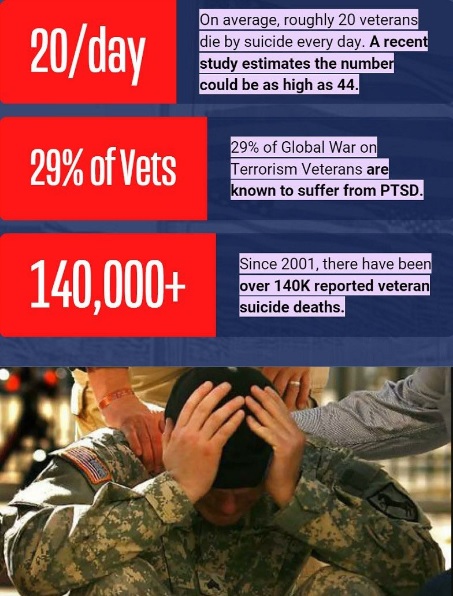
Since 9/11, there has been a staggering increase in veterans taking their own lives. Suicide is now the second leading-cause of death for veterans under 45, the ‘Vetsolutions’ reveals.
When the numbers are laid bare, the crisis is undeniable. According to the U.S. Department of Veterans Affairs (VA) 2024 National Veteran Suicide Prevention Annual Report, there were 6,407 suicides among U.S. veterans in 2022 — an average of about 17.6 veterans per day. Over the period from 2001 to 2022, the data show that suicide among veterans has remained persistently high, despite many prevention efforts. And when you sum across those years, the cumulative toll is staggering: tens of thousands of veterans lost, every year, many of them years or decades removed from active duty, many struggling silently. Yes, definitional and measurement issues mean that some cumulative estimates vary (some advocacy groups cite more than 140,000 veterans since 2001). But the magnitude is clearly enormous.
The scope of the crisis
The 2024 VA report shows that for veterans aged 18 and older, the suicide rate remains significantly higher than for non-veteran U.S. adults. Specifically, the report estimates a veteran suicide mortality rate of 34.7 per 100,000 compared with 17.1 per 100,000 among non-veteran U.S. adults in 2022. Age, sex, and other demographic variations matter. For example, younger veterans (ages 18-34) show particularly high rates in certain analyses.
The veteran population has been declining over the years (from about 25.8 million in 2001 to 18.5 million in 2022) yet the daily number of veteran suicide deaths rose from about 16.5 per day in 2001 to 17.6 per day in 2022. Another layer: methods. A large majority of veteran suicides involve firearms.
The report and independent analyses indicate that firearm involvement is extremely common among veteran suicides. So: the numbers are clear, the consistent pattern is clear, and the burden is heavy.
Mental-health conditions tied to service and trauma
Many veterans experience traumatic events in service: combat, repeated deployments, military sexual trauma, exposure to moral injury (situations in which deeply held beliefs are violated). Such experiences raise risk for conditions like PTSD, depression, anxiety, substance use disorders. The VA report notes meaningful reductions in suicide rates for veterans who have certain mental-health diagnoses and who receive care—but nonetheless the risk remains elevated.
The fact that there is credible debate about the true magnitude — some analyses suggesting maybe ~24 veteran suicides per day rather than 17.6 — shows that the system undercounts and under-understands the crisis. Without better data, prevention cannot be fully evidence-based or well-targeted.
In short: the system doesn’t treat veteran suicide as a full public-health issue with upstream, midstream and downstream components; it treats it too much as a downstream “mental health clinic” problem. That mindset ensures many lives are lost.
read more in our Telegram-channel https://t.me/The_International_Affairs

 10:11 15.11.2025 •
10:11 15.11.2025 •






















